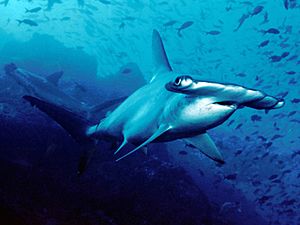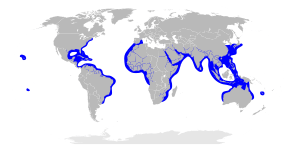Scalloped hammerhead facts for kids
Quick facts for kids Scalloped hammerhead shark |
|
|---|---|
 |
|
| Conservation status | |
| Scientific classification | |
| Kingdom: | |
| Phylum: | |
| Class: | |
| Subclass: | |
| Order: | |
| Family: | |
| Genus: | |
| Species: |
S.lewini
|
 |
|
| Map of where the Scalloped Hammerhead Shark is found (In blue) | |
The scalloped hammerhead (Sphyrna lewini) is a type of hammerhead shark. It got its name because its head looks like a hammer with a wavy, or "scalloped," front edge. The word Sphyrna comes from a Greek word meaning "hammer."
This shark is also called the "bronze hammerhead" or the "kidney-headed hammerhead." You can find it in warm temperate and tropical coastal waters all over the world. It lives between 46° North and 36° South latitudes. It is the most common type of hammerhead shark.
Contents
About the Scalloped Hammerhead
Like all other hammerhead sharks, the scalloped hammerhead has a special "hammer" shape on its head. This part is called the "cephalofoil." The shark's eyes and nostrils are located at the ends of this hammer-shaped head.
Scalloped hammerheads usually grow to be about 1.5 to 2.7 meters (5 to 9 feet) long. The longest one ever found was 4.3 meters (14 feet) long. The heaviest one weighed 150 kilograms (330 pounds). These sharks are usually olive, bronze, light brown, or grey-brown in color. Their bellies are white. Young sharks have darker edges on their fins, but these get lighter as they grow older.
How They Are Named
The scalloped hammerhead was first given the name Zygaena lewini. Later, in 1834, its name was changed to Sphyrna lewini. The name Sphyrna is a Greek word. It means "hammer," which perfectly describes the shape of this shark's head.
Where Scalloped Hammerheads Live
The scalloped hammerhead is a coastal pelagic species. This means it lives both near the coast and in the open ocean. You can find it near continental and insular shelves. It also lives in deeper waters nearby.
These sharks prefer warm temperate and tropical coastal waters around the globe. They live between 46° North and 36° South latitudes. They can be found at depths of over 500 meters (1,600 feet). However, they usually stay in waters shallower than 25 meters (82 feet).
Scalloped Hammerhead Behavior
During the day, scalloped hammerheads often stay close to the shore. At night, they hunt for food further out in the ocean. Adult sharks are usually found alone, in pairs, or in small groups. Young scalloped hammerheads, however, often gather in very large groups. These groups can have a hundred or even more members.
While scalloped hammerheads are generally considered not dangerous to humans, there have been a few reports of attacks. Sometimes, these attacks might have been caused by the great hammerhead shark instead.
What They Eat
Scalloped hammerheads eat different kinds of fish. Their diet includes sardines, mackerel, and herring. They also sometimes eat cephalopods, which are sea creatures like octopuses and squids. These sharks have even been known to eat other smaller species of sharks. Examples include the Blacktip reef shark and the Atlantic sharpnose shark.
Reproduction and Life Cycle
Scalloped hammerheads are viviparous. This means the mother shark carries her young inside her body. She gives birth to live pups, just like mammals do. Female sharks are pregnant for about 9 to 10 months. After this time, they give birth to 15 to 30 baby sharks, called pups. Young scalloped hammerheads grow slowly compared to other sharks. Their fins are also darker than those of adult sharks.
Endangered Status
In 2008, the scalloped hammerhead was put on the "globally endangered" list. This means their numbers are decreasing worldwide. Studies show that in some parts of the Atlantic Ocean, their populations have dropped by 95% in the last 30 years.
The main reason for this decline is too much fishing, especially for shark fins. Shark fins are used to make shark fin soup. Many people are asking for a ban on "shark finning." This is a cruel practice where a shark's fins are cut off, and the rest of the animal is thrown back into the water to die. Hammerhead sharks are among the most common sharks caught for their fins.
Images for kids
See also
 In Spanish: Tiburón martillo común para niños
In Spanish: Tiburón martillo común para niños







